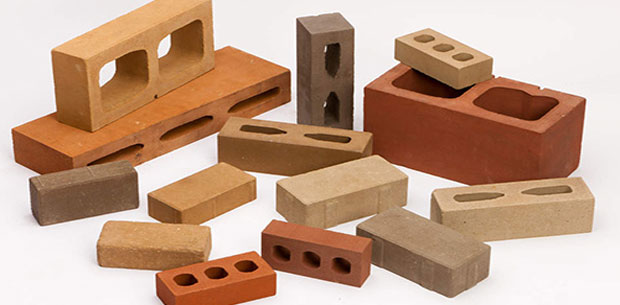
There are different types of bricks available on the market used for various kinds of purposes. These bricks can be categorized under various headings and subheadings on different basis. The various classifications of types of bricks are briefly discussed below.
Classification based on method of manufacturing
Bricks can broadly be categorized into two types as follows on the basis of how its manufactured:
- Unburnt or sun-dried bricks
- Burnt bricks
Unburnt bricks
Unburnt bricks or sun-dried bricks are the types which are dried with the help of heat received from sun after the process of moulding. These bricks can only be used in the construction of temporary and cheap structures. Such bricks should not be used at places exposed to heavy rains.
Burnt Bricks
Burnt bricks are prepared by burning the brick-mould in the kiln inside the factory. These are the most commonly used bricks for construction works. They can be further classified into following four categories:
First class bricks
These bricks are table-moulded and of standard shape and they are burnt in kilns. The surfaces and edges of the bricks are sharp, square, smooth and straight. They comply with all the qualities of good bricks. These bricks are used for superior work of permanent nature.
Second class brick
These bricks are ground-moulded and they are burnt in kilns. The surface of these bricks is somewhat rough and shape is also slightly irregular. These bricks may have hair cracks and their edges may not be sharp and uniform. These bricks are commonly used at places where brickwork is to be provided with a coat of plaster.
Third class bricks
These bricks are ground-moulded and they are moulded in kilns. These bricks are not hard and they have rough surfaces with irregular and distorted edges. These bricks give dull sound when struck together. They are used for unimportant and temporary structures and at places where rainfall is not heavy.
Fourth class bricks
These are over-burnt type of brick with irregular shape and dark colour. These bricks are used as aggregate for concrete in foundations, floors, roads, etc. because of the fact that the over-burnt bricks have a compact structure and hence they are sometimes found to be stronger than even the first class bricks.
Classification based on shape
The ordinary bricks are rectangular solids. But sometimes the bricks are given different shapes to make them suitable for particular type of construction. Here we have enlisted different types of bricks available with various shapes:
- Bullnose brick: A brick moulded with a rounded angle is termed as a bullnose. This type of brick is used for a rounded quoin. A connection which is formed when a wall takes a turn is known as quoin. The centre of the curved position is situated on the long centre-line of brick.
- Channel bricks: These types of bricks are moulded to the shape of a gutter or a channel and they are often glazed. These bricks are used to function as drains.
- Coping bricks: These bricks are made to suit the thickness of walls on which coping is to be provided. Such bricks take various forms such as chamfered, half round or saddle-back.
- Cownose bricks: A brick moulded with a double bullnose on end is known as a cownose.
- Curved sector bricks: These bricks are in the form of curved sector and they are used in the construction of circular brick masonry pillar, brick chimneys, etc.
- Hollow bricks: These are also known as the cellular or cavity bricks. Such bricks have wall thickness of about 20mm to 25mm. They are prepared from special homogeneous clay. They are light in weight about one-third the weight of the ordinary brick of the same size. These types of bricks can be laid almost about four times as fast as the ordinary bricks and thus the use of such bricks leads to speedy construction. They also reduce the transmission of heat, sound and damp. They are used in the construction of partitioning.
- Paving bricks: These bricks are prepared from clay containing a higher percentage of iron. The excess iron vitrifies the bricks at a low temperature. Such bricks resist better the abrasive action of traffic. The paving bricks may be plain or chequered. These bricks are extensively used for garden walks, street pavements, stable floors, etc. These types of bricks also render the floor less slippery.
- Perforated bricks: These bricks contain cylindrical holes throughout their thickness. These bricks are light in weight and they require less quantity of clay for their preparation. The drying and burning of these bricks are also easy. If perforated bricks of large size are used, it will result in the increase of output of mason. The perorated bricks are used in the construction of panels for lightweight structures and multi-storeyed framed structures. They may be circular, square rectangular or any other regular shape in cross-section. The distance between the side of brick and edge of perforation should not be less than 15mm. The distance between the edges of successive perforations should preferably be not less than 10mm. The water absorption after immersion for 24 hours in water should not exceed 15 percent by weight. The compressive strength of perforated bricks should not be less than 7 N/mm2 on gross area.
- Purpose-made bricks: In order to achieve certain purpose, these types of bricks are made. The splay or cant bricks are made for jambs of doors and windows. The arch bricks are made of wedge shape to keep mortar joint of uniform thickness. The ornamental bricks are prepared for corbels, cornices, etc. Similarly, engineering bricks are prepared for constructions where high durability, compression strength and adequate resistance to sudden shocks are required. These types of bricks are usually more costly than the ordinary bricks. But they grant safe, clean and quick construction. Hence, their cost is justified by their excellent performance in situation for which they are purposely prepared.

